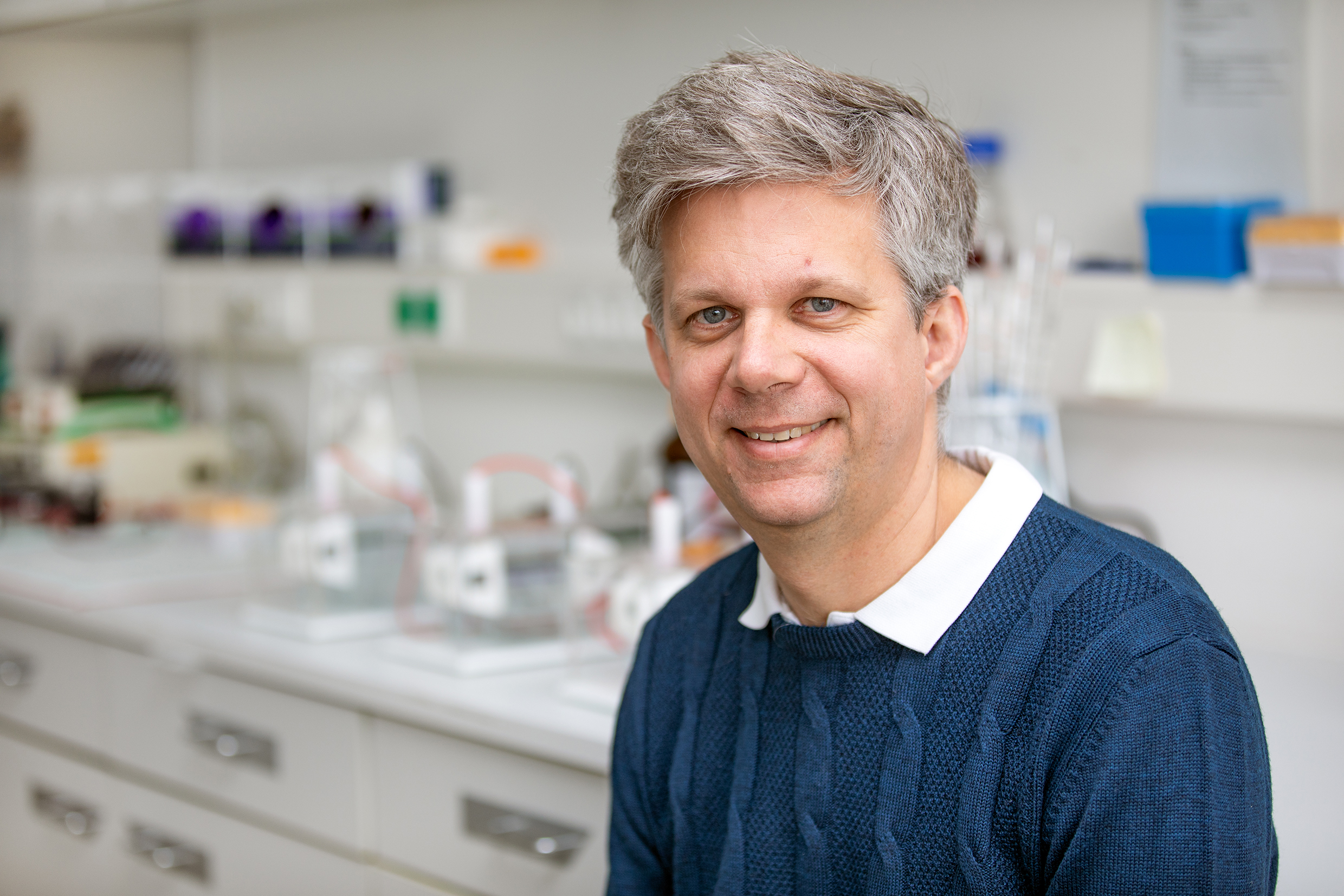Dölken lab
Research summary
Systems and RNA biology of herpesvirus infections
Herpesviruses are large DNA viruses that have co-evolved with their human and animal hosts for millions of years. Eight different herpes viruses infect humans and cause a broad spectrum of diseases ranging from the common cold sores to cancer. During these millions of years of co-evolution hosts, herpesviruses learned to comprehensively modulate their host cell environment and efficiently evade the immune system. Besides representing important pathogens to human health, they represent interesting tools to study fundamental aspects of cell biology and immunology. Within their large DNA genomes, herpesviruses encode hundreds of viral proteins and peptides, many of which not only regulate a single gene, DNA or protein but interfere with complex cellular signal networks. A systems-level approach is required to see beyond the tip of the iceberg of this regulation. Our lab employs a broad range of system biology methodology and analysis tools to study host cell modulation and immune evasion in various herpesvirus models from single-cell to organismal levels.
Herpesviral manipulation of the host transcriptional machinery
Unlike other viruses such as SARS-CoV-2, herpesviruses uniquely exploit the host’s transcriptional machinery to express their large DNA genomes. This process of cellular gene expression is subject to rapid alterations induced by both viral and antiviral mechanisms during lytic infection. Standard approaches that quantify changes in total RNA and protein levels lack the necessary temporal resolution to elucidate the underlying molecular mechanisms. Our lab has pioneered the use of metabolic labelling of newly transcribed RNA using 4-thiouridine (4sU-tagging). This innovative approach allows us to analyze short-term changes in RNA synthesis, processing and decay with superior resolution (Dölken et al., RNA 2008; Friedel et al., NAR 2009; Windhager et al., Genome Research 2012; Rutkowski et al., Nature Communications 2015;). We are using this method to study how herpesviruses manipulate the host transcriptional machinery during productive and latent infection. For instance, during lytic HSV-1 infection, we discovered that HSV-1 triggers widespread, host-specific disruption of transcription termination, leading to extensive transcriptional activity for tens of thousands of nucleotides and downstream genes. We have elucidated the underlying molecular mechanism and its functional consequences for productive infection (PMID: 37172056). We are currently studying additional viral means of manipulating the cellular transcriptional machinery, the underlying molecular mechanisms, and the host defence mechanisms to detect and counteract this.
Functional reannotation of herpesvirus genomes
Applying systems biology methodologies like RNA-seq and ribosome profiling (Ribo-seq) revealed that herpesvirus gene expression is substantially more complex. Within their 165-230kb genomes, they encode hundreds of novel transcripts and open reading frames (ORFs). Based on a broad range of systems biology data, including transcription and translation start site profiling, ribosome profiling and quantitative proteomics, we re-annotate the genomes of HSV-1 (REF) as well as murine and human cytomegalovirus (MCMV/HCMV) (PMID: 29529017, PMID: 37172056). We also developed a new nomenclature to incorporate the novel gene products into the existing nomenclature. A particularly interesting finding from ribosome profiling experiments is hundreds of novel small herpesvirus ORFs (sORFs). Most of these are expressed upstream of previously annotated larger ORFs that represent upstream open reading frames (uORFs). Cellular uORFs are prevalent in eukaryotic genomes and constitute an important yet poorly understood regulatory network governing gene expression at the translation level. We hypothesize that viral uORFs allow these viruses to adapt viral gene expression to cell type, stress and inflammation. Moreover, we are interested in the functional role of small viral RNAs during the different phases of the viral life cycle (Hennig et al., Nature 2022).
Transcriptional regulation at single-cell level
Single-cell RNA sequencing (scRNA-seq) has highlighted the important role of intercellular heterogeneity in phenotype variability in health and disease. Gene expression is a stochastic process, with intrinsic and extrinsic noise in transcription and translation contributing to intercellular heterogeneity in mRNA and protein levels. However, this inherent characteristic cannot be resolved using current scRNA-seq approaches. A further key limitation of all existing methods is that the RNA profile of each cell can only be analyzed once. We combined metabolic RNA labelling using 4-thiouridine with chemical nucleoside conversion and scRNA-seq to develop thiol-(SH)-linked nucleotide conversion sequencing (scSLAM-seq) (Erhard et al., Nature 2019). Our close collaborator Florian Erhard (https://erhard-lab.de/) developed the computational approach GRAND-SLAM (Global Refined Analysis of Newly transcribed RNA and Decay rates using SLAM-seq) to quantify the new-to-total RNA ratio (NTR) for thousands of genes in tens of thousands of cells. We are now exploiting scSLAM-seq's super-resolution to decipher virus-host interactions at single-cell level. The long-term goal is to decipher viral and cellular mechanisms with important regulatory roles during latency, reactivation and productive infection and develop novel means of intervention.
Group members
Principle Investigator
Prof. Dr. med. Lars Dölken

Medizinische Hochschule Hannover (Hannover Medical School)
Institute of Virology, OE5230
Carl-Neuberg-Str. 1
30625 Hannover
Departmental Secretary +49 511 532 6736
Laboratory +49 511 532 - 1470 / -19821 | FAX +49 511 532 8736
Email doelken.lars@mh-hannover.de
Prof. Dölken studied Medicine at the Ernst-Moritz-Arndt University of Greifswald and the University of Otago, Dunedin, New Zealand. From 2005-2011, he specialized in microbiology, virology and infection epidemiology at the Max-von-Pettenkofer Institute in Munich. During this time, he established a research focus on RNA biology of herpesvirus infection, developing new tools for high-resolution gene expression profiling and studying the functional role of herpesvirus small noncoding RNAs. In 2011, he moved to the University of Cambridge, UK, as an MRC Clinical Scientist Fellow. In 2015, he was appointed chair of virology at the Julius-Maximilians-University of Würzburg. He obtained two consecutive ERC grants (2017: HERPES, 2022: DecipherHSV) to study viral manipulation of the host transcriptional machinery by HSV 1 during lytic infection and latency/reactivation. Since 2018, he has been the speaker of the DFG research unit FOR2830 (Advanced Concepts in the Cellular Immune Control of Cytomegalovirus). In April 2024, he was appointed chair of virology at the Institute of Virology at Hanover Medical School. Moreover, he received a Niedersachsen Professorship from zukunft.niedersachsten. (https://zukunft.niedersachsen.de/drei-professuren-fur-niedersachsen/)
Publications in peer-reviewed journals, Reviews, Book chapters, Comments etc.
Selected Publications:
- Costa B, Becker J, Krammer T, Mulenge F, Durán V, Pavlou A, Gern OL, Chu X, Li Y, Čičin-Šain L, Eiz-Vesper B, Messerle M, Dölken L, Saliba AE, Erhard F, Kalinke U.
Human cytomegalovirus exploits STING signaling and counteracts IFN/ISG induction to facilitate infection of dendritic cells.
-> Nat Communications 15(1):1745. DOI: 10.1038/s41467-024-45614-3 - Schmidt N, Ganskih S, Wei1 Y, …, Dölken L, …, Munschauer M. (2023).
The host protein SND1 bind SARS-COV-2 negative-sense RNA and promotes nascent viral RNA synthesis
-> Cell 186(22):4834-4850.e23. DOI: 10.1016/j.cell.2023.09.002 - Djakovic L, Hennig T, Reinisch K, Milić A, Whisnant AW, Wolf K, Weiß E, Haas T, Grothey A, Jürges CS, Kluge M, Wolf E, Erhard F, Friedel CC, Dölken L. (2023).
The HSV-1 ICP22 protein selectively impairs histone repositioning upon Pol II transcription downstream of genes.
-> Nature communications 14(1):4591. DOI: 10.1038/s41467-023-40217-w - Hennig T, Prusty AB, Kaufer BB, Whisnant AW, Lodha M,…, Dölken L*, Prusty BK*. (2022).
Selective inhibition of miRNA processing by a herpesvirus-encoded miRNA.
-> Nature 605(7910):539-544. DOI: 10.1038/s41586-022-04667-4 - Erhard F, Saliba AE, Lusser A, Toussaint C, Hennig C, Prusty BK, Kirschenbaum D, Abadie K, Miska EA, Friedel CC, Amit I, Micura R, Dölken L. (2022).
Time-resolved single-cell RNA-seq using metabolic RNA labelling.
-> Nature Reviews Methods Primers 2, 77. https://www.nature.com/articles/s43586-022-00157-z - Whisnant AW, Jürges CS, Hennig T, Wyler E, Prusty B, …, Erhard F*, Dölken L*. (2020).
Integrative functional genomics decodes herpes simplex virus 1.
-> Nature Communications 11(1):2038. DOI: 10.1038/s41467-020-15992-5 - Wang X, Hennig T, Whisnant AW, Erhard F, Prusty BK, Friedel CC, Forouzmand E, Hu W, Erber L, Chen Y, Sandri-Goldin RM, Dölken L*, Shi Y*. (2020).
Herpes simplex virus blocks host transcription termination via the bimodal activities of ICP27.
-> Nature Communications 11(1):293. DOI: 10.1038/s41467-019-14109-x - Erhard F, Baptista MAP, Krammer T, Hennig T, Lange M, Arampatzi P, Jürges CS, Theis FJ, Saliba AE, Dölken L. (2019).
scSLAM-seq reveals core features of transcription dynamics in single cells.
-> Nature 571(7765):419-423. DOI: 10.1038/s41586-019-1369-y - Erhard F, Halenius A, Zimmermann C, L'Hernault A, Kowalewski DJ, Weekes MP, Stevanovic S, Zimmer R, Dölken L. (2018).
Improved Ribo-seq enables identification of cryptic translation events.
-> Nature Methods 15(5):363-366. DOI: 10.1038/nmeth.4631 - Rutkowski AJ, Erhard F, L'Hernault A, Bonfert T, Schilhabel M, Crump C, Rosenstiel P, Efstathiou S, Zimmer R, Friedel CC, Dölken L. (2015).
Widespread disruption of host transcription termination in HSV-1 infection.
-> Nature Communications 6:7126. DOI: 10.1038/ncomms8126
